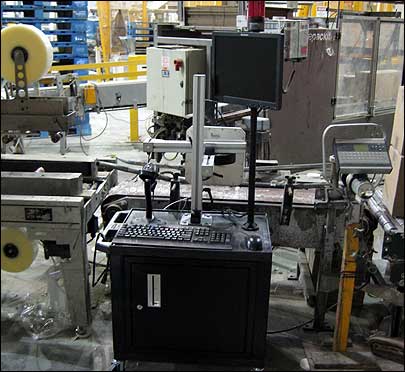Normerica, a provider of cat litter and other products for pet dogs and cats, is among the first to use cardboard boxes with UHF Gen 2 RFID inlays embedded in them. In this way, the company can simply encode an RFID chip on each box destined for Wal-Mart Canada, thereby eliminating the step of attaching Electronic Product Code (EPC) labels to boxes.
To encode the boxes’ RFID tags, the company is employing Impinj RFID interrogators mounted on custom-designed mobile carts provided by Ship2Save. The carts can be wheeled to a conveyor where Wal-Mart-bound products are being packed, thereby reducing the cost of building fixed readers at each conveyor.

The company began testing the system in May, at its plant in Brantford, Ontario. By the end of July, it was sending the products from manufacturing facilities in Brantford to Wal-Mart’s RFID-enabled distribution center in Mississauga.
Normerica began researching RFID options when it was given a July 31 deadline for tagging shipments to Wal-Mart Canada’s Mississauga DC. When the manufacturer attended a Wal-Mart Canada RFID information day in February, the company met with Ship2Save, according to Simon Than, Normerica’s IT director. But, he adds, “We thought it would be great if we could avoid the actual tagging ourselves.”
For the past seven years, Normerica has utilized custom boxes for its bagged kitty litter, provided by Krupack, which is owned by paper and wood products company Kruger. In 2007, Krupack’s sister company, Hide-Pack, developed a method of integrating RFID inlays into boxes that doesn’t slow box production, and partnered with Domino Integrated Solutions Group to market the system to box manufacturers (see Startup Says It Has Cost-Effective Means to RFID-Enable Packaging). Since early 2008, Krupack has been working with Hide-Pack and Domino to offer cardboard boxes with embedded RFID tags.
When Krupack notified Normerica that it offered such boxes, the pet products manufacturer began testing them in May 2008. “We then got back in touch with Ship2Save,” Than says, “to explain the need for an encoding solution, with about two months’ time left on the clock.”
The boxes Krupack is providing have UPM Raflatac ShortDipole EPC Gen 2 inlays embedded in their joints—in the seams, where two sides of a box overlap and are glued together, explains Hide-Pack’s VP and general manager, Paul De Blois. Krupack embeds the inlay in one seam at a corner of the box, then prints the EPC logo and Normerica company name, as well as a bar-coded stock-keeping unit (SKU) number and other text required by Wal-Mart, onto the box’s exterior.
To fill a Wal-Mart order for cat litter at its Brantford facility, Normerica wheels a Ship2Save mobile cart to a conveyor and plugs it into a power source, as well as an Ethernet connection. Employees load the boxes with bags of cat litter, positioning them onto the conveyor so that the RFID-tagged side of each box faces the interrogator. That is necessary, explains Eddie Ng, Ship2Save’s project manager, because the interrogator’s transmission power is set low (with a 2-foot read range) to ensure there are no stray reads of tagged boxes on other conveyor belts.
As a loaded box moves down the conveyor, a worker utilizes a bar-code scanner at the station to read the bar-coded number printed on the box. Ship2Save’s Operation Management System (OMS) software interprets that data on the company’s Microsoft BizTalk Server, located at Normerica’s Toronto office. The bar-coded number is linked to a serial number included in the EPC number assigned to the box, and that number is sent to the mobile cart so its interrogator can encode the EPC onto the tag as it passes the cart.
The cart includes an antenna with a flexible arm, allowing it to be moved to provide the best read angle for boxes on the conveyor. The cart also contains a proximity sensor that senses when a box is coming down the conveyor and prompts the interrogator to begin encoding the tag. The device then reads that tag to determine it has been properly encoded, illuminating a green light if it successfully read the tag, or a red light with an audible alarm if it did not. When Wal-Mart receives the boxes, the retailer can then read their tags in the same manner as any other RFID-labeled case.
The carts, Ng says, were first tested in Ship2Save’s research facility, then taken to Normerica’s its Brantford plant to ensure the company met its July 31 mandate from Wal-Mart. “The carts were prefabricated in our facility,” he states, “then broken down and sent to their plant, where they were reassembled. After that, they went live in a week.” Most of that week, he adds, was spent focusing on employee training.
According to Than, the mobile carts enable the company to expand RFID-tagging to a greater number of production lines, should the need arise, without much additional investment. The mobility of the carts should also prolong the life of the cart’s equipment, he adds, since the carts can be stored away from the dusty production environment when not in use.
“We’re very happy with the system,” Than says. “It’s easy for the production employees to use. It’s relatively low-cost when compared to a slap-and-ship scenario, and it doesn’t disrupt our current workflow.” The costs of a slap-and-ship system would include the expense of the tags and the labor required to attach them to boxes, as well as delays such a system would create in processing a shipment.
Normerica’s plant in Lethbridge, Alberta, also has a cart setup, and the company plans to begin encoding box tags at that facility when Wal-Mart Canada expands its RFID requirements to the rest of the nation. As other Normerica customers become RFID-enabled, Than says, the firm may expand its RFID-tagged box deployment to a large enough percentage of its inventory that it might be worthwhile to install RFID interrogators on its forklift trucks to fully automate the warehousing and shipping processes.


